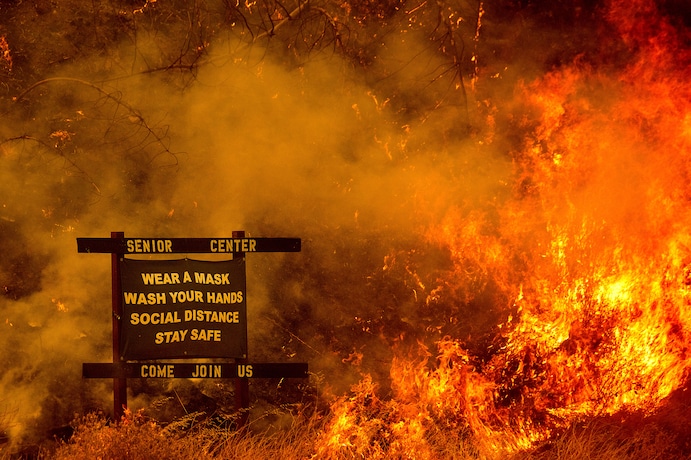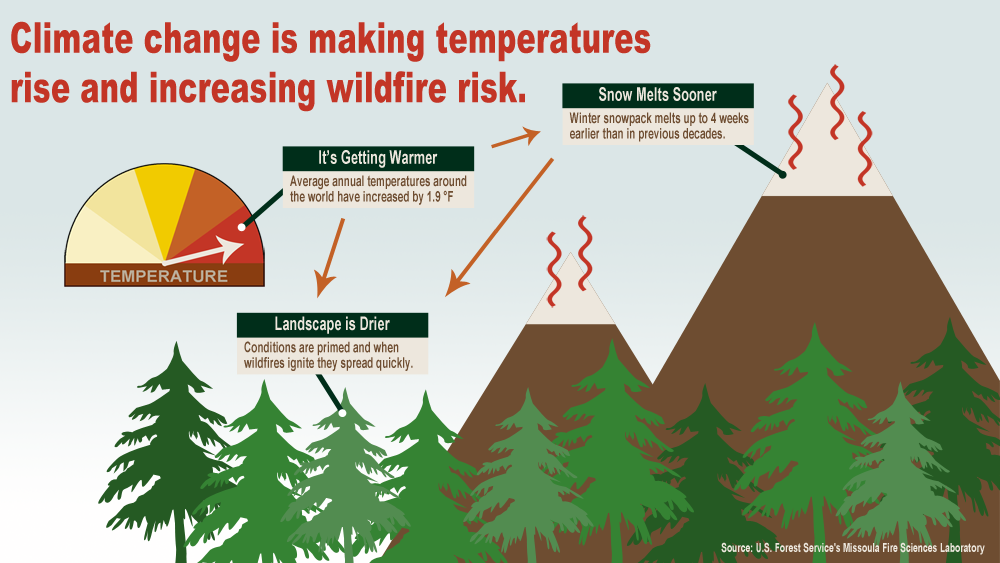Barry Sheppard
Posted September 2, 2020

Record wildfires in the San Francisco Bay Area rapidly erupted in less than two weeks, in the midst of a scorching heat wave.
As of August 24, nearly 120,000 have fled their homes as 1.2 million acres have burned, greater than the state of Rhode Island. Two of the wildfires rank as the second and third largest in California’s history – and they’re still growing. The largest was in 2018.
This is happening during the pandemic, which has caused increased difficulties for those evacuated from their homes, as areas where they find refuge must obey distancing rules so these areas cannot hold as many people.
Over 1,200 homes and other structures have been destroyed.
One of the oldest nature reserves of California giant Redwood trees, some over 2000 years old, has been set ablaze. Some may be saved due to fire-resistant bark that accounts for their old age enduring many fires, but many have not. Already the soaring tops of many of these trees where their branches and green needles are, have been burnt, and it will take years for them to grow back.
The fires continue to rage on. There have been 700 fires, with two dozen major fires that firefighters are still battling.
These fires sprang up in the Greater San Francisco Bay Area encompassing a region from the city to its north, east and south.
Thick smoke, creating unhealthy conditions, has spread over the region, impacting 8 million people.
These fires in the Bay Area were ignited by a freak lightning storm of around 1,200 strikes in one night. These were “dry lightning” strikes. Lightning occurs in thunder storms. “Dry lightning” happens when the air below the storms is hot enough to evaporate most or all of the accompanying rain before it reaches the ground, the present case.
So these strikes sparked the fires without the rain that could have dampened them.
The lightning storm itself was caused by the remnants of a tropical storm that went north in the Pacific from Mexico and then veered into central California and continued north, encountering the heat wave.
California has two seasons, a wet one in the late fall and winter and then a dry one in late spring to fall. Vegetation grows during the wet season and then dries out, providing tinder for fires.
Within the dry season, two types of fire seasons have occurred in recent years. One, which runs from June through September, is driven by a combination of warmer and dryer weather. Those fires tend to be more inland, in higher elevation forests. This is what we are experiencing now.
The second runs from October through April even in the wet season, and is driven by strong westerly hot winds coming from deserts east of California, that cross mountains into the state. These fires tend to spread three times as fast as the earlier ones and burn closer to urban areas. That’s what we can look forward to.
While Californians expect wildfires in the dry months historically, climate change has drastically increased the number of fires as well as their intensity, as we have seen markedly over the last decade. One indication of the effect of global warming is that this decade has seen 10 of the greatest wildfires in the state since records were kept beginning in 1932.
Dr. Park Williams of Columbia University’s Earth Observatory noted in the August 22 New York Times, “Behind the scenes of all this is, you’ve got temperatures that are two to three degrees Fahrenheit warmer now than they would’ve been without global warming.” This has resulted in drier conditions over the past decade.

Determining the links between any individual fire and climate change takes time, and analysis from the evolving science studying this. But the effects of greenhouse gases humans produce underlie everything that occurs in the atmosphere, including the tendency of climate change to make dry places even drier over time. The states in the west, including California, can expect an increasingly fiery future.
Reflecting the austerity policies of capitalism, including in the United States, just as the health system was pared down to where it had no reserves to deal with the pandemic when it struck, the fire fighting system in many states including California is stretched thin.
The thinned out number of firefighters has been augmented by the use of trained prisoner firefighters.
One intersection of the pandemic with the fires is that because the prisons have become epicenters of the virus, some prisoners with less than five years remaining of their sentences have been allowed to go home. Many of the firefighting trained prisoners come from this group, resulting in greatly reducing this pool of firefighters.
California is asking other states and even Australia to send firefighters to alleviate this crisis, which will only get worse in the months ahead.
Given the institutionalized system of mass incarceration, which is the source of the New Jim Crow afflicting the oppressed Black population and other peoples of color, it is no wonder that the prisoner firefighters welcome the chance to get outdoors. They are often used for the most dangerous and difficult jobs, including clearing lines to contain the fires.
They are “paid” $1 an hour. The 13th Amendment to the Constitution passed after the Civil War outlawed slavery – except for prisoners. This was famously used as part of the Jim Crow system exemplified by the notorious “chain gangs”, but is still used today, to outsource slave prison labor to contractors for a price, to help finance the mass incarceration system.
As far as the California prison firefighters are concerned the state doesn’t pay the prisons, but uses these firefighters to reduce its number of regular firefighters, cutting expenses.
Obviously the regular firefighters are fighting to expand the number of regulars instead.
But for the prisoner firefighters, they love their jobs. A recent article in the NYT reports, “Some Californians, including former inmate firefighters, say the program provides a sense of purpose, offering prisoners a chance to prove themselves, and the satisfaction of helping others.
“ ‘It gave me a sense of direction and a sense of worth.’ said Francis Lopez, who spent a year as an inmate firefighter. ‘There are people high-fiving you, there are big signs saying “thank you to the inmates for fighting our fires, for saving our homes,” You can see that and you think, “Wow, I can do good. I can be a person who is being respected.” ….
“His one complaint: Inmates should be given a direct path to a firefighting job once they are released.” Fire departments are loath to hire people with prison records.
While dismantling the system of mass incarceration and slave labor (if it hasn’t already been done so), this experience also indicates what a workers’ state could do in providing real socially useful jobs with pay to offenders as part of the transition to abolishing prisons altogether under socialism.
To return to climate change. Another aspect now occurring on the other side of the country is a rare event: two hurricanes simultaneously forming in the Gulf of Mexico aimed at the U.S. – a harbinger of what experts predict will be an intensification of the hurricane season this year. Global warming does this in two ways. It warms the Atlantic Ocean, the Caribbean Ocean and the Gulf, imparting more energy to hurricanes as well as increasing water dissolved in the atmosphere and thus heavier rains.
This probably has something to do with the tropical storm that formed in the Gulf, crossed Mexico into the Pacific, went north and then became the dry lightning storm that set off the current fires.
